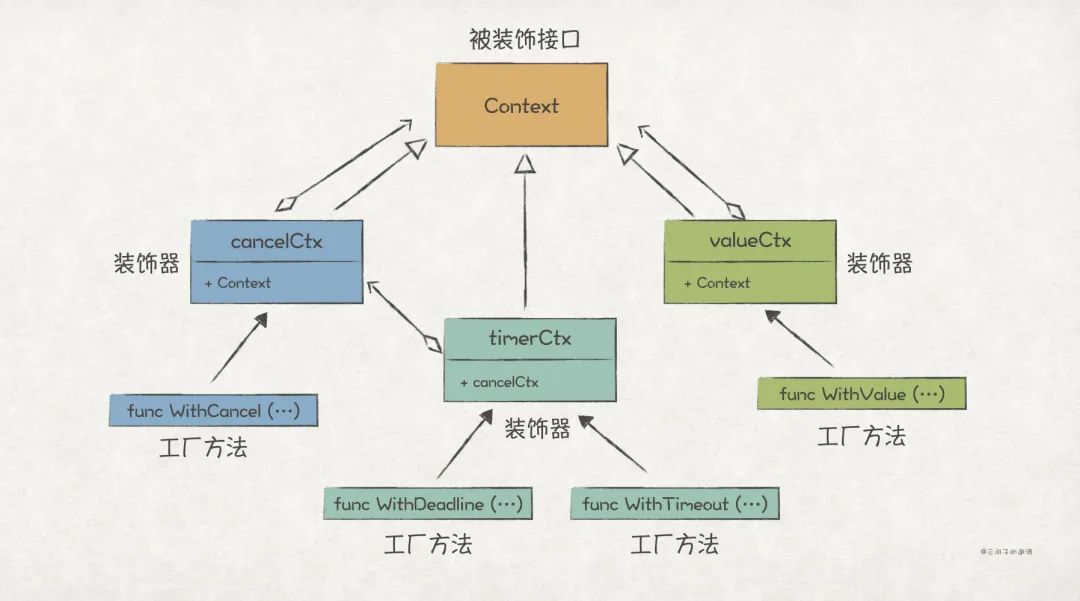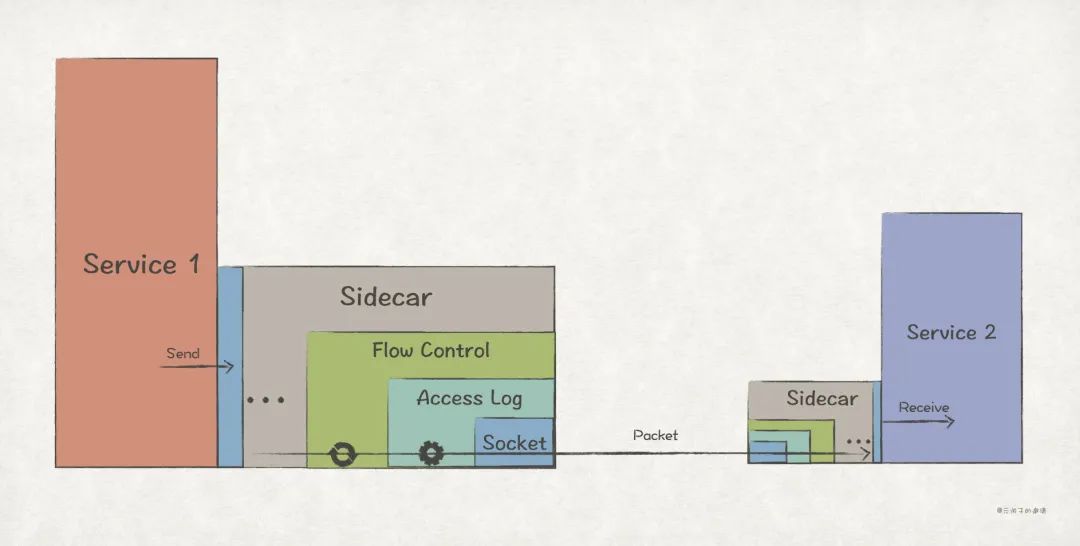【Go实现】实践GoF的23种设计模式:装饰者模式
上一篇:[【Go实现】实践GoF的23种设计模式:原型模式]
简单的分布式应用系统(示例代码工程):https://github.com/ruanrunxue/Practice-Design-Pattern--Go-Implementation
简介
我们经常会遇到“给现有对象/模块新增功能”的场景,比如 http router 的开发场景下,除了最基础的路由功能之外,我们常常还会加上如日志、鉴权、流控等 middleware。如果你查看框架的源码,就会发现 middleware 功能的实现用的就是装饰者模式(Decorator Pattern)。
GoF 给装饰者模式的定义如下:
Decorators provide a flexible alternative to subclassing for extending functionality. Attach additional responsibilities to an object dynamically.
简单来说,装饰者模式通过组合的方式,提供了能够动态地给对象/模块扩展新功能的能力。理论上,只要没有限制,它可以一直把功能叠加下去,具有很高的灵活性。
如果写过 Java,那么一定对 I/O Stream 体系不陌生,它是装饰者模式的经典用法,客户端程序可以动态地为原始的输入输出流添加功能,比如按字符串输入输出,加入缓冲等,使得整个 I/O Stream 体系具有很高的可扩展性和灵活性。
UML 结构
场景上下文
在简单的分布式应用系统(示例代码工程)中,我们设计了 Sidecar 边车模块,它的用处主要是为了 1)方便扩展 network.Socket 的功能,如增加日志、流控等非业务功能;2)让这些附加功能对业务程序隐藏起来,也即业务程序只须关心看到 network.Socket 接口即可。
代码实现
Sidecar 的这个功能场景,很适合使用装饰者模式来实现,代码如下:
// demo/network/socket.go
package network
// 关键点1: 定义被装饰的抽象接口
// Socket 网络通信Socket接口
type Socket interface {
// Listen 在endpoint指向地址上起监听
Listen(endpoint Endpoint) error
// Close 关闭监听
Close(endpoint Endpoint)
// Send 发送网络报文
Send(packet *Packet) error
// Receive 接收网络报文
Receive(packet *Packet)
// AddListener 增加网络报文监听者
AddListener(listener SocketListener)
}
// 关键点2: 提供一个默认的基础实现
type socketImpl struct {
listener SocketListener
}
func DefaultSocket() *socketImpl {
return &socketImpl{}
}
func (s *socketImpl) Listen(endpoint Endpoint) error {
return Instance().Listen(endpoint, s)
}
... // socketImpl的其他Socket实现方法
// demo/sidecar/flowctrl_sidecar.go
package sidecar
// 关键点3: 定义装饰器,实现被装饰的接口
// FlowCtrlSidecar HTTP接收端流控功能装饰器,自动拦截Socket接收报文,实现流控功能
type FlowCtrlSidecar struct {
// 关键点4: 装饰器持有被装饰的抽象接口作为成员属性
socket network.Socket
ctx *flowctrl.Context
}
// 关键点5: 对于需要扩展功能的方法,新增扩展功能
func (f *FlowCtrlSidecar) Receive(packet *network.Packet) {
httpReq, ok := packet.Payload().(*http.Request)
// 如果不是HTTP请求,则不做流控处理
if !ok {
f.socket.Receive(packet)
return
}
// 流控后返回429 Too Many Request响应
if !f.ctx.TryAccept() {
httpResp := http.ResponseOfId(httpReq.ReqId()).
AddStatusCode(http.StatusTooManyRequest).
AddProblemDetails("enter flow ctrl state")
f.socket.Send(network.NewPacket(packet.Dest(), packet.Src(), httpResp))
return
}
f.socket.Receive(packet)
}
// 关键点6: 不需要扩展功能的方法,直接调用被装饰接口的原生方法即可
func (f *FlowCtrlSidecar) Close(endpoint network.Endpoint) {
f.socket.Close(endpoint)
}
... // FlowCtrlSidecar的其他方法
// 关键点7: 定义装饰器的工厂方法,入参为被装饰接口
func NewFlowCtrlSidecar(socket network.Socket) *FlowCtrlSidecar {
return &FlowCtrlSidecar{
socket: socket,
ctx: flowctrl.NewContext(),
}
}
// demo/sidecar/all_in_one_sidecar_factory.go
// 关键点8: 使用时,通过装饰器的工厂方法,把所有装饰器和被装饰者串联起来
func (a AllInOneFactory) Create() network.Socket {
return NewAccessLogSidecar(NewFlowCtrlSidecar(network.DefaultSocket()), a.producer)
}总结实现装饰者模式的几个关键点:
- 定义需要被装饰的抽象接口,后续的装饰器都是基于该接口进行扩展。
- 为抽象接口提供一个基础实现。
- 定义装饰器,并实现被装饰的抽象接口。
- 装饰器持有被装饰的抽象接口作为成员属性。“装饰”的意思是在原有功能的基础上扩展新功能,因此必须持有原有功能的抽象接口。
- 在装饰器中,对于需要扩展功能的方法,新增扩展功能。
- 不需要扩展功能的方法,直接调用被装饰接口的原生方法即可。
- 为装饰器定义一个工厂方法,入参为被装饰接口。
- 使用时,通过装饰器的工厂方法,把所有装饰器和被装饰者串联起来。
扩展
Go 风格的实现
在 Sidecar 的场景上下文中,被装饰的 Socket 是一个相对复杂的接口,装饰器通过实现 Socket 接口来进行功能扩展,是典型的面向对象风格。
如果被装饰者是一个简单的接口/方法/函数,我们可以用更具 Go 风格的实现方式,考虑前文提到的 http router 场景。如果你使用原生的 net/http 进行 http router 开发,通常会这么实现:
func main() {
// 注册/hello的router
http.HandleFunc("/hello", hello)
// 启动http服务器
http.ListenAndServe("localhost:8080", nil)
}
// 具体的请求处理逻辑,类型是 http.HandlerFunc
func hello(w http.ResponseWriter, r *http.Request) {
w.Write([]byte("hello, world"))
}其中,我们通过 http.HandleFunc 来注册具体的 router, hello 是具体的请求处理方法。现在,我们想为该 http 服务器增加日志、鉴权等通用功能,那么可以把 func(w http.ResponseWriter, r *http.Request) 作为被装饰的抽象接口,通过新增日志、鉴权等装饰器完成功能扩展。
// demo/network/http/http_handle_func_decorator.go
// 关键点1: 确定被装饰接口,这里为原生的http.HandlerFunc
type HandlerFunc func(ResponseWriter, *Request)
// 关键点2: 定义装饰器类型,是一个函数类型,入参和返回值都是 http.HandlerFunc 函数
type HttpHandlerFuncDecorator func(http.HandlerFunc) http.HandlerFunc
// 关键点3: 定义装饰函数,入参为被装饰的接口和装饰器可变列表
func Decorate(h http.HandlerFunc, decorators ...HttpHandlerFuncDecorator) http.HandlerFunc {
// 关键点4: 通过for循环遍历装饰器,完成对被装饰接口的装饰
for _, decorator := range decorators {
h = decorator(h)
}
return h
}
// 关键点5: 实现具体的装饰器
func WithBasicAuth(h http.HandlerFunc) http.HandlerFunc {
return func(w http.ResponseWriter, r *http.Request) {
cookie, err := r.Cookie("Auth")
if err != nil || cookie.Value != "Pass" {
w.WriteHeader(http.StatusForbidden)
return
}
// 关键点6: 完成功能扩展之后,调用被装饰的方法,才能将所有装饰器和被装饰者串起来
h(w, r)
}
}
func WithLogger(h http.HandlerFunc) http.HandlerFunc {
return func(w http.ResponseWriter, r *http.Request) {
log.Println(r.Form)
log.Printf("path %s", r.URL.Path)
h(w, r)
}
}
func hello(w http.ResponseWriter, r *http.Request) {
w.Write([]byte("hello, world"))
}
func main() {
// 关键点7: 通过Decorate函数完成对hello的装饰
http.HandleFunc("/hello", Decorate(hello, WithLogger, WithBasicAuth))
// 启动http服务器
http.ListenAndServe("localhost:8080", nil)
}上述的装饰者模式的实现,用到了类似于 [Functional Options] 的技巧,也是巧妙利用了 Go 的函数式编程的特点,总结下来有如下几个关键点:
- 确定被装饰的接口,上述例子为
http.HandlerFunc。 - 定义装饰器类型,是一个函数类型,入参和返回值都是被装饰接口,上述例子为
func(http.HandlerFunc) http.HandlerFunc。 - 定义装饰函数,入参为被装饰的接口和装饰器可变列表,上述例子为
Decorate方法。 - 在装饰方法中,通过for循环遍历装饰器,完成对被装饰接口的装饰。这里是用来类似 [Functional Options] 的技巧,一定要注意装饰器的顺序!
- 实现具体的装饰器,上述例子为
WithBasicAuth和WithLogger函数。 - 在装饰器中,完成功能扩展之后,记得调用被装饰者的接口,这样才能将所有装饰器和被装饰者串起来。
- 在使用时,通过装饰函数完成对被装饰者的装饰,上述例子为
Decorate(hello, WithLogger, WithBasicAuth)。
Go 标准库中的装饰者模式
在 Go 标准库中,也有一个运用了装饰者模式的模块,就是 context,其中关键的接口如下:
package context
// 被装饰接口
type Context interface {
Deadline() (deadline time.Time, ok bool)
Done() <-chan struct{}
Err() error
Value(key any) any
}
// cancel装饰器
type cancelCtx struct {
Context // 被装饰接口
mu sync.Mutex
done atomic.Value
children map[canceler]struct{}=
err error
}
// cancel装饰器的工厂方法
func WithCancel(parent Context) (ctx Context, cancel CancelFunc) {
// ...
c := newCancelCtx(parent)
propagateCancel(parent, &c)
return &c, func() { c.cancel(true, Canceled) }
}
// timer装饰器
type timerCtx struct {
cancelCtx // 被装饰接口
timer *time.Timer
deadline time.Time
}
// timer装饰器的工厂方法
func WithDeadline(parent Context, d time.Time) (Context, CancelFunc) {
// ...
c := &timerCtx{
cancelCtx: newCancelCtx(parent),
deadline: d,
}
// ...
return c, func() { c.cancel(true, Canceled) }
}
// timer装饰器的工厂方法
func WithTimeout(parent Context, timeout time.Duration) (Context, CancelFunc) {
return WithDeadline(parent, time.Now().Add(timeout))
}
// value装饰器
type valueCtx struct {
Context // 被装饰接口
key, val any
}
// value装饰器的工厂方法
func WithValue(parent Context, key, val any) Context {
if parent == nil {
panic("cannot create context from nil parent")
}
// ...
return &valueCtx{parent, key, val}
}
// 使用时,可以这样
func main() {
ctx := context.Background()
ctx = context.WithValue(ctx, "key1", "value1")
ctx, _ = context.WithTimeout(ctx, time.Duration(1))
ctx = context.WithValue(ctx, "key2", "value2")
}不管是 UML 结构,还是使用方法,context 模块都与传统的装饰者模式有一定出入,但也不妨碍 context 是装饰者模式的典型运用。还是那句话,学习设计模式,不能只记住它的结构,而是学习其中的动机和原理。
典型使用场景
- I/O 流,比如为原始的 I/O 流增加缓冲、压缩等功能。
- Http Router,比如为基础的 Http Router 能力增加日志、鉴权、Cookie等功能。
- ......
优缺点
优点
- 遵循[开闭原则] ,能够在不修改老代码的情况下扩展新功能。
- 可以用多个装饰器把多个功能组合起来,理论上可以无限组合。
缺点
- 一定要注意装饰器装饰的顺序,否则容易出现不在预期内的行为。
- 当装饰器越来越多之后,系统也会变得复杂。
与其他模式的关联
装饰者模式和代理模式具有很高的相似性,但是两种所强调的点不一样。前者强调的是为本体对象添加新的功能;后者强调的是对本体对象的访问控制。
装饰者模式和适配器模式的区别是,前者只会扩展功能而不会修改接口;后者则会修改接口。
文章配图
可以在 [用Keynote画出手绘风格的配图] 中找到文章的绘图方法。
参考
[1] [【Go实现】实践GoF的23种设计模式:SOLID原则] , 元闰子
[2] [【Go实现】实践GoF的23种设计模式:建造者模式] , 元闰子
[3] Design Patterns, Chapter 4. Structural Patterns, GoF
[4] 装饰模式, refactoringguru.cn
[5] Golang Decorator Pattern, Henry Du

